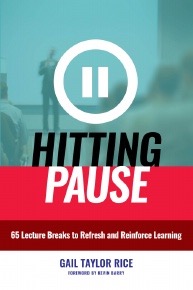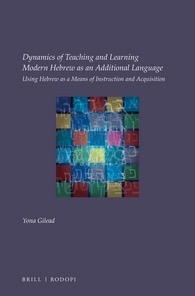teaching strategies
Select an item by clicking its checkbox

Hitting Pause: 65 Lecture Breaks to Refresh and Reinforce Learning
Date Reviewed: January 23, 2019
Timing is everything. It’s true for comedians and, according to Gail Taylor Rice, also for professors. Great comedians can hold an audience’s attention for over an hour because the attack-and-retreat nature of human attention. They know about volume control; high volume must be properly balanced with lower volume. Fast tempos must be tempered with slower tempos.
In the book Hitting Pause, Rice makes a compelling argument in favor of recognizing and designing classes in light of the rhythms of learning. Professors often suffer from the cognitive bias of "the curse of knowledge." This malady makes it nearly impossible for experts to put themselves in the shoes of someone who is learning things for the first time. A result of this curse is that it’s nearly impossible to appreciate how much time is needed for comprehending material.
Rice suggests that learners "might wish that there was a pause button connected to their college professors" (4). The pause button is a great metaphor. I think this idea could also be expanded as a highlighter pen for the lecturer. The professor needs to frequently slow down and make sure that students understand the importance of certain ideas.
The book rightly challenges the status quo of today’s university classroom as a place where professors read PowerPoint slides in darkened rooms while the gravitational pull of more interesting things like Instagram claim the student’s valuable and limited attention. Rice suggests that well-timed pausing can introduce the right kind of novelty and reflection to pull students out of their penchant for succumbing to time-wasting distractions.
Many educators believe the lecture is dead, and good professors will not use them. Lectures, however, aren’t necessarily bad; only bad lectures are bad. Rice offers solid research to give professors tested strategies for designing effective lectures that are punctuated with well-timed opportunities for reflection and emphasis.
According to Rice, starting a class with a pause invites students to become emotionally invested in learning. Again, we are so busy planning what we will teach that we forget to see things from a student’s perspective. An intentional pause forces us to think of starting a class like a pilot preparing for take-off. A good pilot will dutifully attend to a check-list to make sure that the plane is in good condition; teachers also need to consciously attend to their students’ current ability to learn.
The first half of Hitting Pause provides solid research about the pedagogical advantages of pausing. The second half contains numerous examples of starting pauses, mid-pauses, and closing pauses. Each example is categorized by appropriate setting and characteristics for use. The settings for use are divided into small classroom lecture, clinical or laboratory presentation, one-on-one session, conference presentations/in-service education, keynote/large-group presentation, course/unit, and online learning module. The characteristics include: affirming/positive, physical/movement, activates prior knowledge/experience, focuses/refocuses, creates community, generates curiosity, metacognitive, reviews, celebrates, commits to action, and provides a bookend. There are a great variety of examples which can be adapted to work in different settings.
Overall, this is a valuable book for teachers who are hoping to be more learning-centered.

Dynamics of Teaching and Learning Modern Hebrew as an Additional Language: Using Hebrew as a Means of Instruction and Acquisition
Date Reviewed: November 2, 2018
This book examines the use of Hebrew as the primary means of instruction for second or additional language (L2) acquisition at an introductory level in academic contexts where English is the native language. The author, Yona Gilead, seeks to address the relative dearth of theorization on the dynamics of using Hebrew as the primary language for THAL (teaching Hebrew as an additional language) in order to begin to situate it within a larger framework of L2 teaching, learning, and research. Dynamics of Teaching and Learning Modern Hebrew as an Additional Language provides a presentation and analysis of the pedagogy promulgated by the Hebrew University’s Rothberg International School (RIS) adapted for use at an Australian university. In looking at the implementation of the RIS method outside of Israel the book focuses on the adaptability of the Hebrew-in-Hebrew approach for localized use.
In contradistinction to teaching Hebrew from a heritage language perspective, where grammar and literacy are emphasized and the ability to read and analyze culturally important texts such as the Bible, Mishnah, and Talmud are the primary goals of instruction, the RIS method that Gilead evaluates focuses on spoken, workaday Hebrew where the goals are comprehension of aurally received data and generation of intelligible responses. The latter approach, referred to in some broader L2 discussions as the Direct Method, dispenses with grammar altogether, prompting students to learn grammar inductively as a natural consequence of language acquisition. Gilead provides a brief historical background of the RIS method, situating it in its current context amid a larger L2 field, and discusses what is achievable using the RIS method at the introductory level outside of Israel. The major modification of this method for the Australian classroom is the teacher’s prerogative to break, fleetingly, from Hebrew in order to provide a concise grammatical explanation. Certainly Gilead’s analysis, which includes interviews with the participants (students and teacher, independently), shows that the students found that the addition of this allowance was a boon to their understanding; many of the students she interviewed comment that that it was essential to have these breaks for grammar.
Gilead is quite positive about the effectiveness of the technique but does not go into great detail to this end. There is definitely room for discussion, perhaps in a future publication, of how students perform in more advanced levels of instruction. Do students approach literacy while in formal classroom contexts? How does this method serve its students when they are no longer in a structured environment? Does the method prepare them to be life-long learners? Are students able to navigate resources that will allow them to continue learning, especially if they are not in an immersive environment once the class ends?
Overall, the book’s methodology, which includes dialogue, interview, and case study is clear and implemented well. This study raises important pedagogical issues for university Hebrew programs reassessing their curriculum goals and needs. Gilead makes a solid contribution in identifying and theorizing key aspects of THAL classroom dynamics.
“Grab him!” they shouted. “And cage the big dope! Lasso his stomach with ten miles of rope! Tie the knots tight so he’ll never shake loose! Then dunk that dumb speck in the Beezle-Nut juice! Horton fought back with great vigor and vim But the Wickersham gang was too ...
Interrupting Institutional Patterns of Trauma (Non)Response Moving is difficult. In the past twenty years, I’ve moved fifteen times and I am in the middle of another move right now. Some moves were by choice and others due to unexpected circumstances. Moving is laborious–packing, reimagining space, anticipated and ...
Teaching and learning in academic settings can sometimes appear contrived or artificial in relation to the “real” world or professional contexts for which students prepare. However, this does not always have to be the case. One of the things that has surprised me about teaching in theological education is the ...


